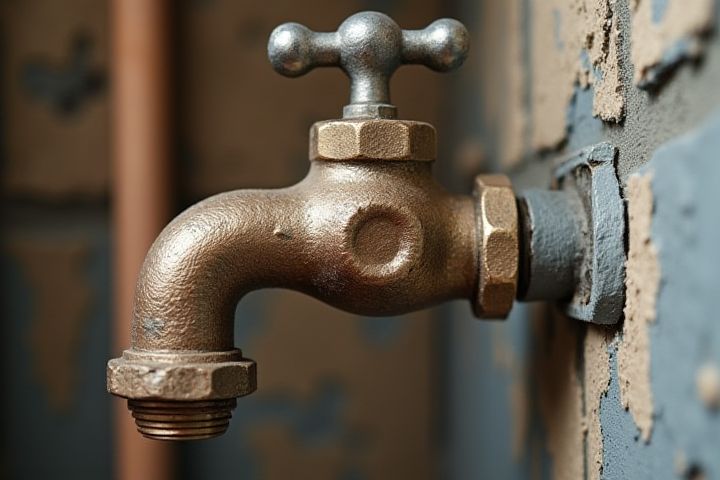
House plumbing can back up due to several common causes. Clogged drains often result from debris accumulation, grease buildup, or hair obstruction, leading to water stagnation in sinks, tubs, or toilets. Tree roots infiltrating underground pipes can also disrupt the flow, causing blockages and potential leaks. Aging plumbing systems may deteriorate, developing cracks or rust that compromise their integrity and capacity. Regular maintenance and inspection of your plumbing can help identify issues before they escalate into significant backups.
Why House Plumbing Backs Up
Clogged pipes
Clogged pipes are a primary cause of house plumbing backups, as debris such as hair, soap scum, grease, and food particles accumulate over time. These blockages restrict the flow of wastewater, leading to pressure build-up and potential overflow in sinks, toilets, and showers. You may also encounter unpleasant odors and slow drainage as warning signs of a clog forming. Regular maintenance, including snaking or hydro jetting, can help prevent these issues, ensuring your plumbing system remains functional and efficient.
Tree root intrusion
Tree root intrusion is a common cause of house plumbing backups, as roots seek out moisture and nutrients often found in sewer pipes. When tree roots penetrate these pipes, they can create obstructions that block the normal flow of wastewater, leading to slow drains and potential overflows. Your plumbing system can be severely damaged if these roots are not addressed promptly, resulting in costly repairs and extensive disruption. Regular inspections and maintenance can help identify root issues early, protecting your home's plumbing infrastructure.
Main sewer line blockage
Main sewer line blockage typically occurs due to the accumulation of debris, tree roots, or shifting soil that obstructs the flow of wastewater. When the sewer line becomes clogged, it prevents sewage from properly draining, causing sewage to back up into your home's plumbing system. Signs of a blockage may include slow drains, gurgling sounds from pipes, or foul odors emanating from sinks and toilets. To address this issue, regular maintenance and inspection of your sewer line can help identify potential problems before they lead to significant backups and costly repairs.
Flushing inappropriate items
House plumbing backups often occur due to flushing inappropriate items, such as paper towels, feminine hygiene products, and excessive amounts of toilet paper. These materials do not dissolve easily in water and can create clogs in pipes, leading to significant drainage issues. Moreover, flushing other items like wet wipes contributes to the formation of blockages in sewage systems as they do not break down like traditional toilet tissue. To prevent backups, it is essential to only flush human waste and toilet paper, ensuring a smoother flow through your plumbing system.
Grease buildup
Grease buildup in house plumbing occurs when fats, oils, and food particles accumulate within pipes, causing clogs and slow drainage. Over time, this residue sticks to the inner walls of your plumbing system, narrowing the passage and obstructing the flow of wastewater. Regularly disposing of cooking grease in the trash instead of pouring it down the sink can significantly reduce the risk of backups. You can also implement preventive measures, such as using strainers in your sinks and performing routine pipe cleanings to maintain optimal drainage.
Poor pipe installation
Poor pipe installation can lead to significant plumbing backups in your home, often manifesting as slow drains or complete blockages. Improperly joined pipes may create gaps or misalignments, allowing debris and waste to accumulate, which disrupts the flow of water. Inadequate slope in drain lines can lead to stagnant water, promoting clogs from hair, grease, and other materials. Ensuring that pipes are correctly installed, including appropriate materials and angles, is crucial for a functional plumbing system.
Broken or collapsed pipes
Broken or collapsed pipes can lead to significant plumbing backups in your home, disrupting daily activities and causing water damage. When pipes fracture, debris and blockages accumulate, preventing the smooth flow of wastewater away from your property. Ground shifting, tree root intrusion, and extreme weather conditions are common culprits that can compromise the structural integrity of your plumbing system. Regular inspections and maintenance can help identify potential weak spots, ensuring your plumbing remains efficient and functional.
Heavy rain or flooding
Heavy rain or flooding can overwhelm your home's drainage system, leading to plumbing backups due to excessive water volume. The increased pressure from saturated soil can cause sewer lines to become blocked or compromised, allowing wastewater to backflow into your home. Stormwater can also infiltrate the sewer system, leading to overloading and potential structural weaknesses in pipes. To mitigate these risks, ensuring proper drainage around your property and checking for blockages during heavy rain events is essential.
Venting issues
House plumbing often backs up due to inadequate venting, which is essential for maintaining proper airflow in drainage systems. When vents are blocked or improperly designed, negative pressure can occur, making it difficult for wastewater to flow freely. This can lead to slow drains or complete backups in sinks, toilets, and showers. Regular inspection and maintenance of vent pipes can help you prevent these plumbing issues and ensure efficient waste removal throughout your home.
Aging plumbing systems
Aging plumbing systems, typically over 30 years old, are prone to significant deterioration, which can lead to backups. The buildup of mineral deposits, rust, and tree root intrusion can obstruct pipes, limiting water flow and causing wastewater to back up into your home. Moreover, older pipes made from materials like cast iron or galvanized steel are more susceptible to leaks and corrosion, further compounding plumbing issues. Regular inspections and maintenance are essential in older homes to mitigate these risks and ensure the plumbing system remains functional.
